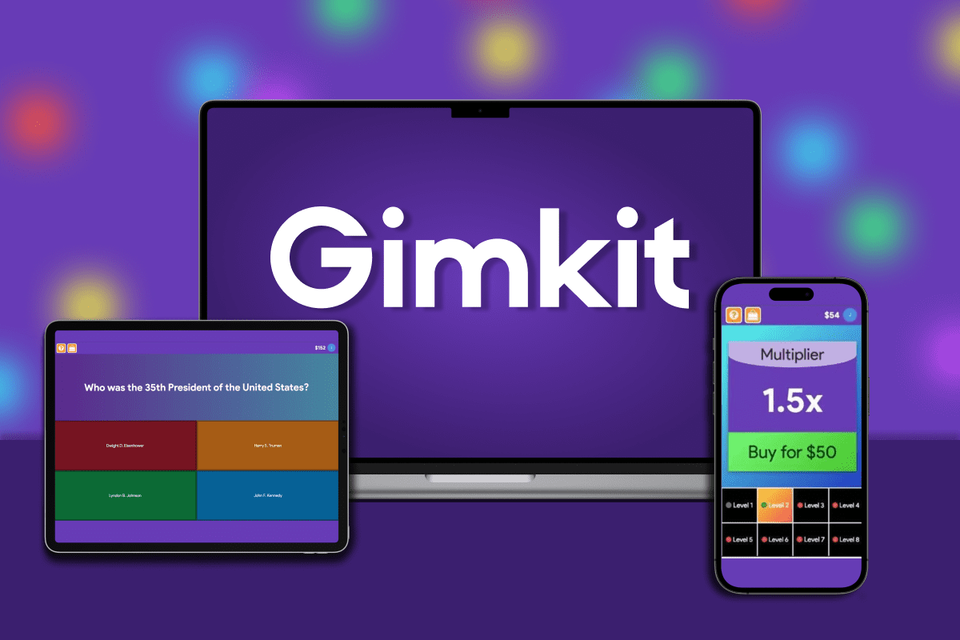
Gimkit is an innovative educational platform that turns learning into an engaging, game-like experience. Developed by a high school student, Josh Feinsilber, Gimkit was born out of the need for a more dynamic learning tool that could make review sessions less repetitive and more exciting. What started as a simple classroom project has evolved into a robust educational game used by thousands of teachers and students around the world.
Unlike traditional quiz platforms, Gimkit adds a layer of strategy and interaction. Students not only answer questions to test their knowledge, but they also earn in-game currency for every correct answer. This currency can then be used to purchase power-ups, upgrade performance, and outsmart competitors. The blend of knowledge reinforcement with competitive gaming is one of the key reasons behind Gimkit’s rising popularity.
The platform's simplicity, coupled with its ability to make learning genuinely fun, makes it a go-to for both in-class activities and remote learning. As classrooms become more digital, tools like Gimkit represent the future of interactive education.
2. How Gimkit Works: A Closer Look at Its Features
Gimkit offers a wide array of features designed to make learning immersive, interactive, and effective. At its core, it's a quiz-based platform, but with enough strategic depth and flexibility to appeal to a variety of learning styles and classroom goals.
Real-Time Game Mechanics
In Gimkit, speed and accuracy are key. Students join a game session via a unique code, answer questions in real time, and earn virtual cash for each correct response. Unlike traditional quizzes where a wrong answer simply means fewer points, Gimkit’s real-time feedback mechanism makes every question count. Students can immediately see how well they're doing, and the currency they earn adds a layer of investment in the game.
The real-time aspect also fosters a sense of urgency and focus, keeping students more engaged. This structure allows students to stay motivated, as they see tangible rewards for their efforts in real time.
Kit Creation and Customization
One of Gimkit’s strongest features is its customizable "kits." A kit is essentially a set of questions grouped by a subject or theme. Teachers can create kits from scratch, import them from Quizlet, or search the public library for ready-made options.
Teachers have full control over the question types, answer choices, and even the pacing of the questions. This flexibility means you can tailor the content exactly to your curriculum or differentiate by student skill level. Some teachers even allow students to help build kits, giving them more ownership of the content and deeper engagement.
Integration With Classroom Learning
Gimkit isn’t just about fun—it’s a learning tool built for results. Teachers receive detailed reports after each session, which help them identify strengths and weaknesses in student understanding. Whether you're using it for review, practice, or even assessment, Gimkit allows you to track student performance in a meaningful way.
The platform is also compatible with Google Classroom, making it easy to assign kits and track participation. Teachers can control game length, enable specific modes, and adjust question difficulty to match their instructional goals.
3. The Different Modes of Play in Gimkit
Gimkit stands out from other educational platforms because it offers several different modes of gameplay. These modes bring variety to the learning experience and can be tailored depending on classroom needs or student preferences.
Classic Mode vs. Team Mode
Classic Mode is the default setup, where students compete individually. It’s a great choice when you want to gauge individual performance or encourage personal improvement. Students race against one another to earn as much virtual money as they can before the game ends.
Team Mode, on the other hand, emphasizes collaboration. Students are grouped into teams and work together to achieve a common goal. This mode is ideal for cooperative learning and promotes peer-to-peer interaction, helping quieter students feel more comfortable participating.
Trust No One: The Among Us-Inspired Mode
Trust No One is one of Gimkit’s most unique and exciting gameplay modes. Inspired by the popular game "Among Us," this mode introduces imposters into the mix. Players must answer questions while trying to figure out who the imposters are, all while completing game objectives.
This format encourages critical thinking, social reasoning, and collaboration. It brings a fun, suspenseful twist to academic review that students love. It’s also an effective way to blend entertainment with meaningful learning.
The "KitCollab" Feature
KitCollab turns students into content creators. Instead of the teacher generating all the questions, KitCollab lets students submit their own. The teacher approves each one, ensuring quality control, and then they’re added to the final kit.
This mode fosters creativity and accountability, as students must think critically about how to form a good question and answer pair. It also boosts engagement, as students are more invested in a game built around their contributions.
4. Benefits of Using Gimkit in the Classroom
There are many reasons educators across the globe are incorporating Gimkit into their lesson plans. From boosting engagement to providing actionable insights, here are some of the key advantages of using Gimkit in educational settings.
Increases Student Engagement
Let’s face it—traditional review worksheets and tests can be boring. Gimkit introduces a competitive edge that captivates students' attention. Whether they're trying to earn more virtual money or unlock a new power-up, students are more likely to stay focused and excited about the material.
Teachers often report higher participation rates and a greater willingness from students to revisit material when Gimkit is involved. It's a game-changer—literally.
Encourages Repetition and Mastery
Because Gimkit is fun, students are more likely to play multiple times. This repetition is crucial for long-term retention. The platform encourages a growth mindset by rewarding improvement and persistence.
Even if students don't perform well the first time, the game incentivizes them to keep trying, refining their understanding with each round. Over time, this leads to deeper mastery of the content.
Data-Driven Instruction for Teachers
After each session, teachers receive detailed performance analytics. These reports show which questions were most commonly missed, how long students spent on each answer, and overall performance trends.
With this data, teachers can adjust their instruction to focus on problematic areas, group students for intervention, or even assign follow-up tasks. It turns informal review sessions into meaningful assessments.
5. Tips and Best Practices for Teachers New to Gimkit
If you're new to Gimkit, diving in can feel overwhelming. But with a few best practices, you can quickly get up and running—and make the most of what the platform offers.
Start simple: use a public kit or import a Quizlet set to get familiar with the game format. Don't try every feature at once; instead, introduce new modes gradually so students can learn how each one works. Team Mode is a great entry point for new users, as it promotes collaborative learning and eases students into the game mechanics.
Take advantage of KitCollab to involve students in the content creation process—it builds ownership and makes the review session more personalized. Finally, explore the power-up system, but set some limits to keep gameplay balanced and focused on learning outcomes.
Remember, Gimkit is a tool. Use it flexibly to meet your students’ needs, whether that means daily warmups, test review, or even homework assignments. The key is consistency and creativity—once you find your groove, the results will speak for themselves.
#Gimkit #Gim kit #Gimkit join #Gimkitjoin #Gimkit Host #Gimkithost













